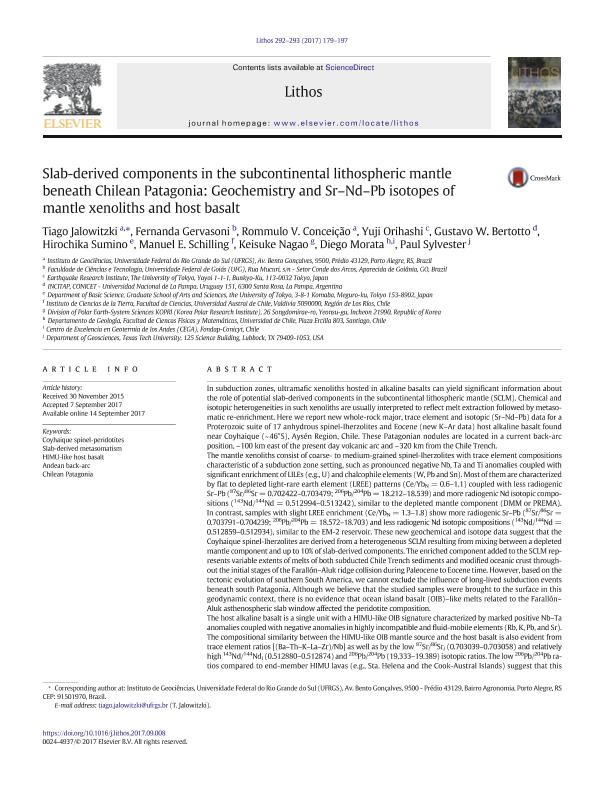Mostrar el registro sencillo del ítem
dc.contributor.author
Jalowitzki, Tiago
dc.contributor.author
Gervasoni, Fernanda
dc.contributor.author
Conceição, Rommulo V.
dc.contributor.author
Orihashi, Yuji

dc.contributor.author
Bertotto, Gustavo Walter

dc.contributor.author
Sumino, Hirochika

dc.contributor.author
Schilling, Manuel E.
dc.contributor.author
Nagao, Keisuke
dc.contributor.author
Morata, Diego
dc.contributor.author
Sylvester, Paul
dc.date.available
2018-04-16T20:10:38Z
dc.date.issued
2017-11
dc.identifier.citation
Jalowitzki, Tiago; Gervasoni, Fernanda; Conceição, Rommulo V.; Orihashi, Yuji; Bertotto, Gustavo Walter; et al.; Slab-derived components in the subcontinental lithospheric mantle beneath Chilean Patagonia: Geochemistry and Sr–Nd–Pb isotopes of mantle xenoliths and host basalt; Elsevier Science; Lithos; 292-293; 11-2017; 179-197
dc.identifier.issn
0024-4937
dc.identifier.uri
http://hdl.handle.net/11336/42197
dc.description.abstract
In subduction zones, ultramafic xenoliths hosted in alkaline basalts can yield significant information about the role of potential slab-derived components in the subcontinental lithospheric mantle (SCLM). Chemical and isotopic heterogeneities in such xenoliths are usually interpreted to reflect melt extraction followed by metasomatic re-enrichment. Here we report new whole-rock major, trace element and isotopic (Sr?Nd?Pb) data for a Proterozoic suite of 17 anhydrous spinel-lherzolites and Eocene (new K?Ar data) host alkaline basalt found near Coyhaique (~46°S), Aysén Region, Chile. These Patagonian nodules are located in a current back-arc position, ~100 km east of the present day volcanic arc and ~320 km from the Chile Trench.The mantle xenoliths consist of coarse- to medium-grained spinel-lherzolites with trace element compositions characteristic of a subduction zone setting, such as pronounced negative Nb, Ta and Ti anomalies coupled with significant enrichment of LILEs (e.g., U) and chalcophile elements (W, Pb and Sn). Most of them are characterized by flat to depleted light-rare earth element (LREE) patterns (Ce/YbN = 0.6?1.1) coupled with less radiogenic Sr?Pb (87Sr/86Sr=0.702422?0.703479; 206Pb/204Pb=18.212?18.539) and more radiogenic Nd isotopic compositions (143Nd/144Nd = 0.512994?0.513242), similar to the depleted mantle component (DMM or PREMA). In contrast, samples with slight LREE enrichment (Ce/YbN=1.3?1.8) show more radiogenic Sr?Pb (87Sr/86Sr=0.703791?0.704239; 206Pb/204Pb =18.572?18.703) and less radiogenic Nd isotopic compositions (143Nd/144Nd=0.512859?0.512934), similar to the EM-2 reservoir. These new geochemical and isotope data suggest that the Coyhaique spinel-lherzolites are derived from a heterogeneous SCLM resulting from mixing between a depleted mantle component and up to 10% of slab-derived components. The enriched component added to the SCLM represents variable extents of melts of both subducted Chile Trench sediments and modified oceanic crust throughoutthe initial stages of the Farallón?Aluk ridge collision during Paleocene to Eocene time. However, based on the tectonic evolution of southern South America, we cannot exclude the influence of long-lived subduction events beneath south Patagonia. Although we believe that the studied samples were brought to the surface in this geodynamic context, there is no evidence that ocean island basalt (OIB)?like melts related to the Farallón?Aluk asthenospheric slab window affected the peridotite composition.The host alkaline basalt is a single unit with a HIMU-like OIB signature characterized by marked positive Nb?Ta anomalies coupledwith negative anomalies in highly incompatible and fluid-mobile elements (Rb, K, Pb, and Sr).The compositional similarity between the HIMU-like OIB mantle source and the host basalt is also evident from trace element ratios [(Ba?Th?K?La?Zr)/Nb] as well as by the low 87Sr/86Sri (0.703039?0.703058) and relatively high 143Nd/144Ndi (0.512880?0.512874) and 206Pb/204Pb (19.333?19.389) isotopic ratios. The low206Pb/204Pb ratios compared to end-member HIMU lavas (e.g., Sta. Helena and the Cook-Austral Islands) suggest that this region was modified by processes associated with a prolonged period of subduction related to the Andean orogenesis and the recycling of several oceanic plates beneath the continent, following the Mesozoic breakup of Gondwana or an even older subduction-related event with young recycling ages (b2 Ga).
dc.format
application/pdf
dc.language.iso
eng
dc.publisher
Elsevier Science

dc.rights
info:eu-repo/semantics/openAccess
dc.rights.uri
https://creativecommons.org/licenses/by-nc-sa/2.5/ar/
dc.subject
Coyhaique Spinel-Peridotites
dc.subject
Slab-Derived Metasomatism
dc.subject
Himu-Like Host Basalt
dc.subject
Andean Back-Arc
dc.subject.classification
Meteorología y Ciencias Atmosféricas

dc.subject.classification
Ciencias de la Tierra y relacionadas con el Medio Ambiente

dc.subject.classification
CIENCIAS NATURALES Y EXACTAS

dc.title
Slab-derived components in the subcontinental lithospheric mantle beneath Chilean Patagonia: Geochemistry and Sr–Nd–Pb isotopes of mantle xenoliths and host basalt
dc.type
info:eu-repo/semantics/article
dc.type
info:ar-repo/semantics/artículo
dc.type
info:eu-repo/semantics/publishedVersion
dc.date.updated
2018-04-16T14:41:02Z
dc.journal.volume
292-293
dc.journal.pagination
179-197
dc.journal.pais
Países Bajos

dc.journal.ciudad
Amsterdam
dc.description.fil
Fil: Jalowitzki, Tiago. Universidade Federal do Rio Grande do Sul; Brasil
dc.description.fil
Fil: Gervasoni, Fernanda. Universidade Federal de Goiás; Brasil
dc.description.fil
Fil: Conceição, Rommulo V.. Universidade Federal do Rio Grande do Sul; Brasil
dc.description.fil
Fil: Orihashi, Yuji. University of Tokyo; Japón
dc.description.fil
Fil: Bertotto, Gustavo Walter. Consejo Nacional de Investigaciones Científicas y Técnicas. Instituto de Ciencias de la Tierra y Ambientales de La Pampa. Universidad Nacional de La Pampa. Facultad de Ciencias Exactas y Naturales. Instituto de Ciencias de la Tierra y Ambientales de La Pampa; Argentina
dc.description.fil
Fil: Sumino, Hirochika. University of Tokyo; Japón
dc.description.fil
Fil: Schilling, Manuel E.. Universidad Austral de Chile. Facultad de Ciencias. Instituto de Ciencias de la Tierra; Chile
dc.description.fil
Fil: Nagao, Keisuke. Korea Polar Research Institute; Corea del Sur
dc.description.fil
Fil: Morata, Diego. Comisión Nacional de Investigación Científica y Tecnológica; Chile. Universidad de Chile; Chile
dc.description.fil
Fil: Sylvester, Paul. Texas Tech University; Estados Unidos
dc.journal.title
Lithos

dc.relation.alternativeid
info:eu-repo/semantics/altIdentifier/doi/https://doi.org/10.1016/j.lithos.2017.09.008
dc.relation.alternativeid
info:eu-repo/semantics/altIdentifier/url/https://www.sciencedirect.com/science/article/pii/S0895981117303656
Archivos asociados
